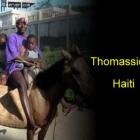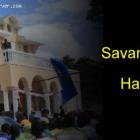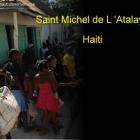ADVERTISEMENT
Race in Haiti - Haiti Observer Blog
Race in Haiti, Haiti Observer Blog. Read the following articles about Race in Haiti
Dany Laferriere, How To Make Love To A Negro Without Getting Tired
Haitian born writer Dany Laferrière has spent his career writing things that provoke. From his work in the weekly 'Le Petit Samedi Soir' to his first novel, 'How to make love to a Negro' (1987), Laferrière has carved his success with the blade of controversy, whether real or formulated.
He was born in Port-au-Prince as Windsor Kléber Laferrière on April 13, 1953. After growing up in Petit Goâve, he began working as a journalist until the late 1970's when the weekly he wrote in collaboration with Gaston Raymond most likely led to the murder of the latter. Laferrière felt it best to relocate to Canada.
Francois-Wolff Ligonde, who presided over Duvalier- Bennett wedding is Dead
An ardent supporter of the Duvalier regime, Haitian Bishop Francois-Wolff Ligonde passed away. According to Radio Kiskeya based on information obtained from Bishop Louis Kebreau, he died following an unspecified illness.
Bishop Francois-Wolff Ligonde was born in the city of Les Cayes, on January 17, 1928. On August 20, 1966, Pope Paul VI nominated him as Archbishop of Port-au-Prince. After more than 40 years in this position, Bishop Francois-Wolff Ligonde retired from his post in 2008.
Bishop Francois-Wolff Ligonde became famous when he presided over the wedding of Jean Claude Duvalier and Michele Bennett, whom he is the uncle. The wedding that many people believe marked the beginning of the end of the regime. There were several issues on the table with this particular wedding: One, Michele Bennett, a mulatto who came opposed to the Noirisme movement that Francois Duvalier has been promoting throughout his government. Two, the wedding itself in 1980 cost over $5 millioms.
Populist President Dumarsais Estime
Dumarsais Estime, Haiti's 33rd president, held office for four years. His presidency is notable because he was the first black leader elected after the U.S. occupation ended in 1934.
Although Estimé married a mulatto elite, his determined educated blacks were to make up the majority of his administration's political appointees. Reversing mulatto elite influence, he championed an education initiative, building schools in poverty-ridden villages and offering advanced teacher-training. This effort created a 45% rise in elementary school attendance.
Dumarsais Estime's agenda included road-construction projects, literacy programs, and improving community services. He also amended the Constitution to provide workers the right to form unions and raised the minimum wage.
Francois Duvalier, Minister of Public Health under Dumarsais Estime
Francois Duvalier who was appointed under the government of Estime, joined the government of President Dumarsais Estime, becoming director general of the national public health service. In 1948 he is appointed as minister of public health and labor.
After the military coup that overthrown the Estime regime on 10 May. 1950, Duvalier returns to his medical career. However, quietly and behind the scenes he begins organizing against the military regime that was in place then. By 1954 he is the central opposition figure and goes underground, hiding inside of the country.
The election of Dumarsais Estime represented a break with the traditional Haitian politic at the time. For one, he was anti-elitist and therefore generally anti Mulatto. The constitution was changed and came into effect in November 1946. He increased the representation of middle-class and lower-class blacks in the public sector and suggested that voodoo be considered as a religion equivalent to Roman Catholicism
Antihaitianismo, a racial prejudice manifested In Dominican Culture
The Hispaniola Island is shared by the Dominican Republic and Haiti for around 150 years. But both countries do not share an amicable relationship. Antihaitianismo is a set of anti prejudices that have been created by antagonism in the Dominican Republic.
Evolution Of Racial Prejudice
Antihaitianismo is the evolution of racial prejudices manifested for a long time, misinterpretation of selective historical facts and creation of false consciousness in the Dominican Republic. The elite groups, who were powerful and having strong interests to defend, orchestrated the long term revolution.
Inhabitants from Spain colonized Santo Domingo and it was then that racial prejudices started leading to antihaitianismo. Racial prejudice, slavery besides sugar was brought to the island due to Spanish colonization. Administration was controlled by elite white Spanish who ruled over the slaves and creoles.
Canaval telling story of Haiti - Haitian Afranchi
The term Affranchi was a French legal term classifying some slaves after obtaining their freedman or emancipation
This was a social class in the former Haiti, Saint-Domingue. The Affranchi at the time were in the social class between those who were free whites and enslaved Black people.
The Afranchi class was not only determined by your skin color at the time. Some of them werefreed people of mixed race and others were freed blacks. For instance, a mixed child born of a white father and a black mother was born free and would fall under the Afranchi class
Who is the Real Haitian?
Is there such a thing as a real Haitian? Is it an ethnic confluence? A little Spanish blood here, a little French blood there? Is the real Haitian an émigré from the Congo? What about the lightness or darkness of skin tone? Is darker more Haitian than light? Or vice versa?
Does a real Haitian speak Créole or French? Are they Catholic, Protestant, or Voodoo believers? What kind of music do they listen to? To the big band sound of the 40s and 50s? Compás, Zouk, Racine? Or music that can only be described as country or folk? Is Manno Emmanuel Charlemagne or Emeline Michel the real Haitians, rather than T-Vice or Shleu-Shleu?
Antenor Firmin's Contributions to Bioanthropology
Cap-Haitien-born Anténor Firmin was one of the earliest scholars to write on the subject of negritude. Conceivably the first anthropologist of color, he introduced the notion of human anthropology as allied with the study of racial characteristics.
During the late 1800s, a strain of thinking pervaded U.S. and European intellectual circles, arguing the African race as low on the evolutionary scale in comparison to Caucasians. The French were dominating the conversation of the African race as intellectually inferior, due to misguided assumptions of racial differences. A prominent French author, Count Arthur de Gobineau, published "Essay on the Inequality of Human Races" that posited supremacy of the Aryan people over Africans and other dark-skinned races.
New Video raising the race factor in Haiti 2010 Election
We just received a videotape raising the issue of race in the Haiti 2010 Presidential election. The main question, according to Mr. Wilner Nau who produced this videotape was:
How can we Haitian, with over 90% of the population being of African descent, elect a White Man in 2010? Mr. Nau further stated that Haiti is the first Black independent nation in the Caribbean. Over 100,000 Haitians were killed to put the white people out of the country. For a country that killed White people to get its independence, Mr. Nau would like to know what to say the next time a Jamaican, people from Trinidad and Tobago, or anyone who is working with him asks him the question: "What's up with your White President"
Our objective is to share with you news and information about Haiti and the people of Haiti. Traditions, habits and the way we were or grew are alive in this site. We highly recommend that you Subscribe to our Newsletter and also share with us some of the things that are memorable and made us unique people.

 Haitian Thanksgiving
Haitian Thanksgiving  Informative Marketing and Advertising in the Haitian Community
Informative Marketing and Advertising in the Haitian Community  Thomassique, Haiti
Thomassique, Haiti  The Town of Savanette, Haiti
The Town of Savanette, Haiti  Saint Michel de L 'Atalaye
Saint Michel de L 'Atalaye